×
Save 20% On Your Purchase!
Use code SAVE20 at checkout to save on your purchase today from my Herbal Shop!
×
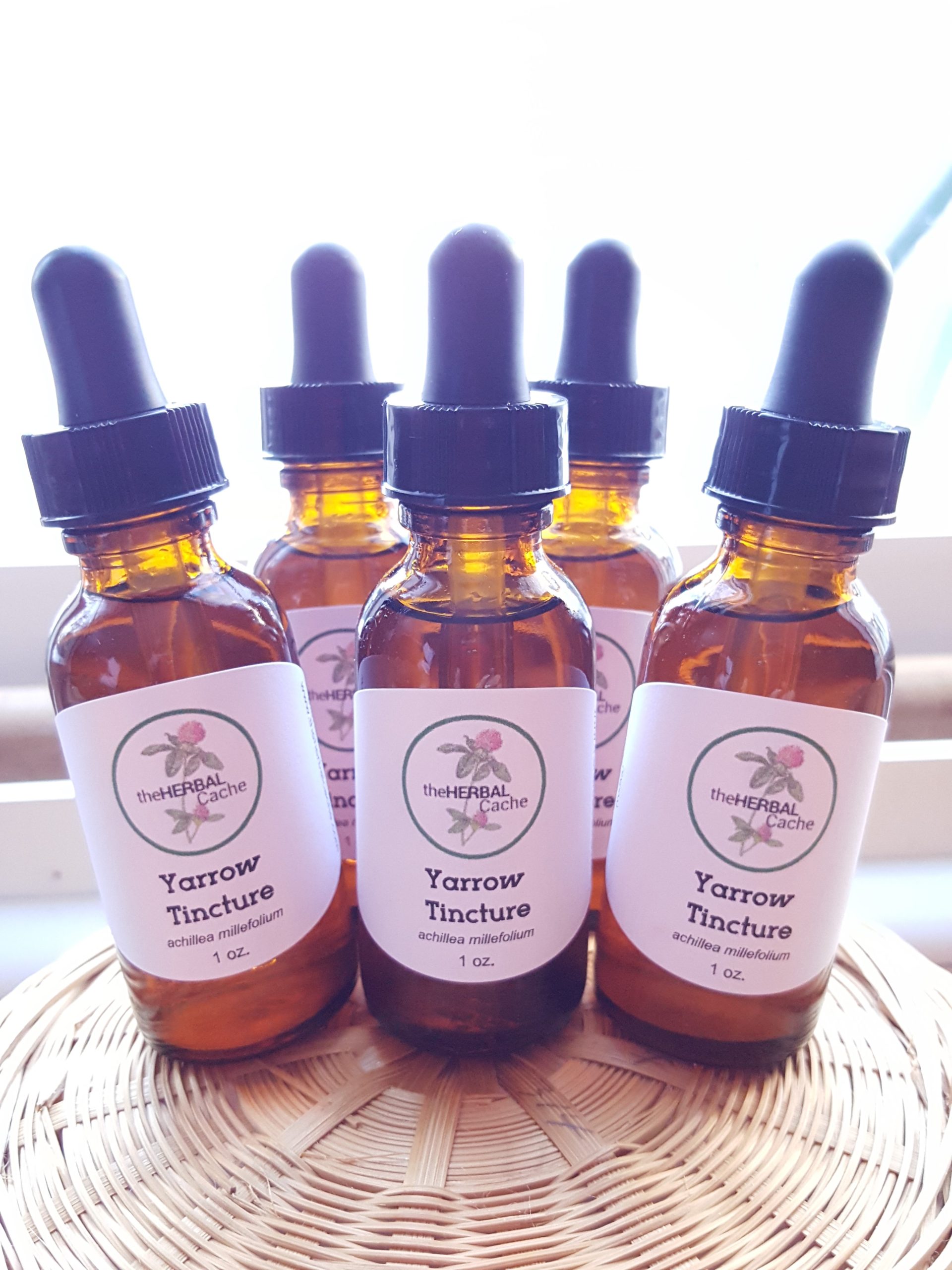
The world is a nettle; disturb it, it stings. Grasp it firmly, it stings not.
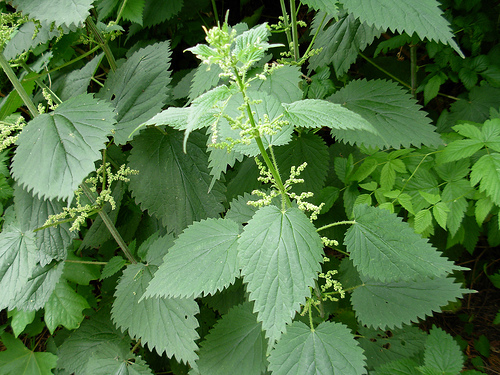
Stinging nettle has been used for centuries to treat various maladies, including anemia, arthritis and skin diseases. Its leaves are edible in salads or cooked like spinach.
And yet many people see it as a weed and want to pull it up by its roots to eradicate it.
But the benefits of stinging nettle include supporting urination, increasing blood flow and reducing neural inflammation.
Let me show you that this plant is more than just a weed.
Stinging nettle is generally considered a weed and can be found growing wild in woodlands and on river banks. It also prefers disturbed soils, such as on farmsteads, manure piles or near abandoned buildings.
Stinging nettles have long fleshy roots that can grow deep into the ground. This is important, because this is how the plant becomes so nutritious, by pulling up vitamins and minerals deep in the soil.
The leaves, stems and roots are covered in tiny hairs that release histamine and other chemicals that can sting painfully. These chemicals cause an itchy, irritating sensation on the skin which only lasts about 15 minutes.
Growing up, my mother called this plant “itch weed”, because it made you itch. So I highly recommended that you wear gloves when handling this plant. Or if you want to get the true feeling of stinging nettle, don’t.
This plant is a very fast grower and spreads easily by seed or underground shoots.
For optimal nutrition and medicinal properties, it should be picked before flowers appear. I like to harvest the tops in early spring when the plants are still young. They will grow back, so you can get a number of pickings.
Susun Weed says to grasp it by a top leaf and cut just the very top (no more than 8 leaves) and put that in the foraging basket. Since nettles are so fibrous, she says to only pick the very tops. If the scissors have difficulty cutting, it’s too far down.
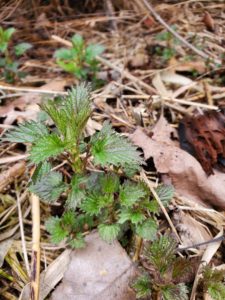
The leaves and young shoots of stinging nettle are edible. They have a slightly bitter, nutty flavor that most find pleasant. Nettle leaves can be a simple substitute for spinach in any dish.
Nettles are rich in vitamins A, C, D and K as well as iron, potassium, calcium and manganese.
One serving of stinging nettle provides almost all of the recommended daily allowance for vitamin K per day.
Nettles are also rich in chlorophyll, which gives them their green color and may be responsible for some of its health benefits.
Two studies published in the “Journal of Agricultural and Food Chemistry” evaluated the antioxidant activity of nettle extract and found it to be higher than other popular drinks like cranberry juice, grape juice and green tea. The researchers concluded that the high antioxidant activity may be due to nettle’s chlorophyll content.
The leaves are said to have a beneficial effect on the urinary system because they contain high amounts of potassium, calcium and magnesium. They also can help reduce inflammation in the bladder lining which may prevent chronic infections from developing.
In addition to its nutritional value, some studies suggest that stinging nettle may also have medicinal properties.
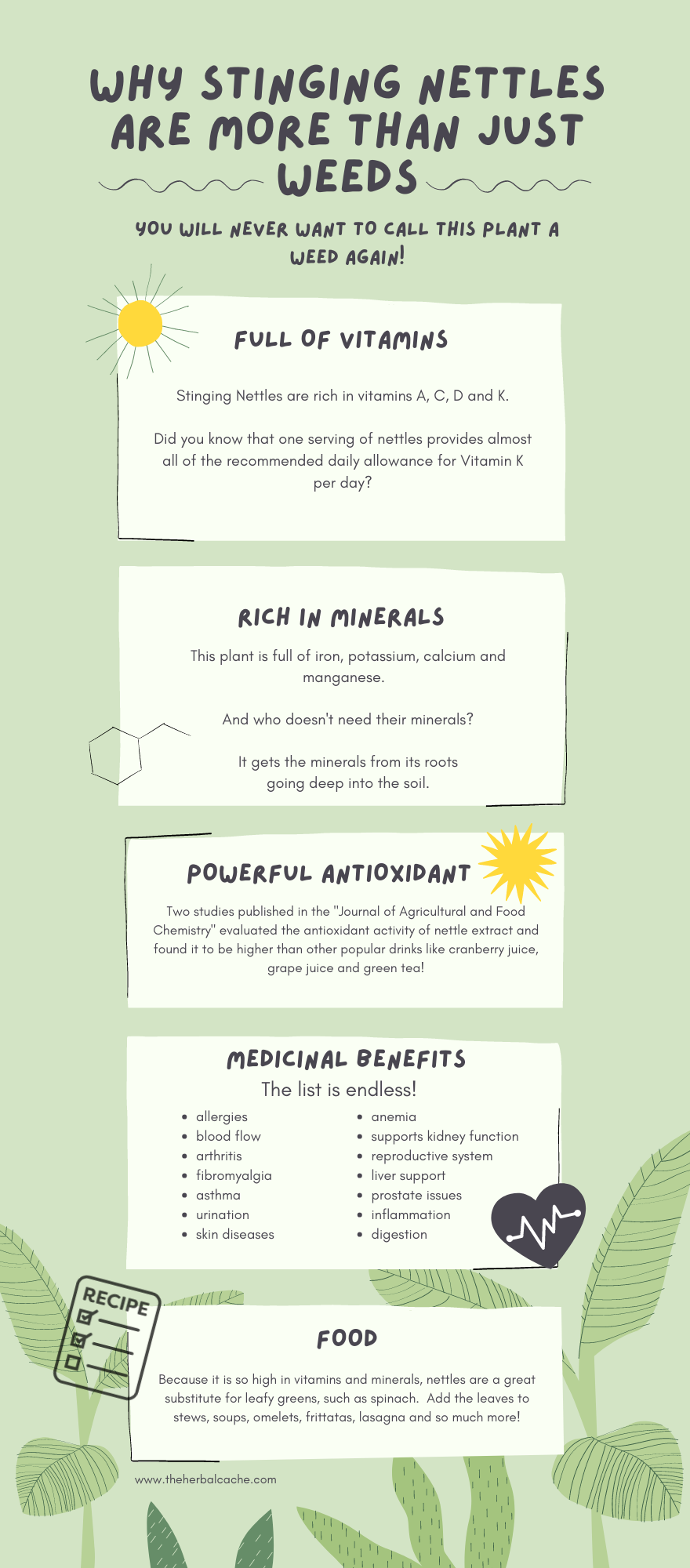
In addition to its nutritional content, stinging nettle is said to have medicinal properties. Its roots and leaves are used in traditional herbal remedies for conditions such as anemia, arthritis and skin diseases. In addition, modern uses include supporting urination and increasing blood flow. Nettle root may also help relieve symptoms of the common cold.
One small study published in the “Journal of Complementary and Alternative Medicine” found that patients who suffered from frequent colds showed a significant decrease in number of colds after taking nettle root extract daily for 12 weeks. These results were not found with the placebo group.
Another study conducted by researchers at the University of Virginia found that drinking stinging nettle tea reduced the total number of colds by more than one-third among patients who suffered from chronic respiratory infections.
Brigitte Mars talks about how people have used nettles for thousands of years to help with pain from arthritis, fibromyalgia and as an early substitute for Viagra! By gently brushing a stem of leaves over one’s skin, the irritation causes a huge blood flow to the area (called irtication). Thus helping with pain, inflammation, etc.
Nettle is a wonderful herb for those with allergies. A study published in “Alternative Therapies in Health and Medicine” suggested that an extract from this plant may reduce inflammatory responses due to allergies, which suggests it may be effective in relieving symptoms of allergies and asthma.
Herbalist Matthew Wood says the seeds in particular, may help get rid of allergies, both food allergies and seasonal ones. He also recommends the root be taken for prostate problems.
Stinging nettle also helps get rid of mucus in the lungs.
David Hoffman calls this plant the “ultimate green tonic”. That should tell you something.
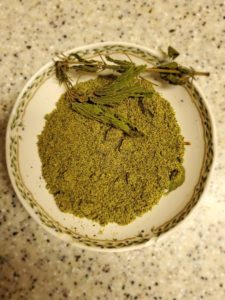
There are a number of ways you can incorporate stinging nettle into your diet.
A very easy way is to cook it like spinach or added to soups and stews for extra nutritional benefit. Herbalist Rosemary Gladstar likes to saute it with a little olive oil, lemon juice and feta cheese.
Herbal Revolution preserves their nettles like this to to enjoy all year:
These little “patties” can be added to soup, pesto, sautéed, in frittata, scrambled eggs, smoothies, etc. This could also be done with dandelion greens!
The young shoots may also be eaten fresh or steamed. But make sure to get the tops of young plants. Nettles are very fibrous in older plants and growth near the ground.
To make stinging nettle tea, steep one teaspoon of dried herb for eight to 10 minutes in hot water. This makes an excellent substitute for coffee that is high in antioxidants and many other nutrients.
People who suffer from chronic conditions like allergies and arthritis may find relief by drinking stinging nettle tea.
Taking nettle in a tincture form is available if you can’t stomach eating the greens, or don’t like drinking teas. As a tincture, it is a more concentrated and you can take it as needed. You can find tinctures in most natural food or wellness stores.
Making a herbal decoction with nettles is another great way to take this plant. Just follow these simple instructions:
My favorite way to use nettles is by making Nettle Gomasio! This herbal spice blend can be used on almost everything. I personally like it on my fried eggs and popcorn.
In the video below, I show you just how easy it is to make your own Nettle Gomasio!
I hope I have shown you just how beneficial stinging nettles are for us.
Not only are they nutritious in terms of the vitamins and minerals they provide, but they also help support our health and body in a number of ways.
Nettles have been around for thousands of years, and I hope they will be around for a thousand more. Because we need them.
So go and “nettle” up!
Have you ever had one of those moments when, from out of the blue, you have a fantastic idea or thought? Well, I had one today, an idea for this blog post – the color green.
It all started this morning when I got a manicure and pedicure, something to prep me up for our upcoming vacation. I don’t do this often, so it is quite the treat for me.
For my nail colors, I chose two shades of green, my favorite color. I’ve done pinks and reds a couple of times, but I just don’t care for the “pop” they have. They are just a little to bold for me. So I just stick with the good ol’ natural green.
Later, after I got home and was working on some household chores, it occurred to me that I put a lot of “green” in my life. Green fingernails, plants, clothes, etc.
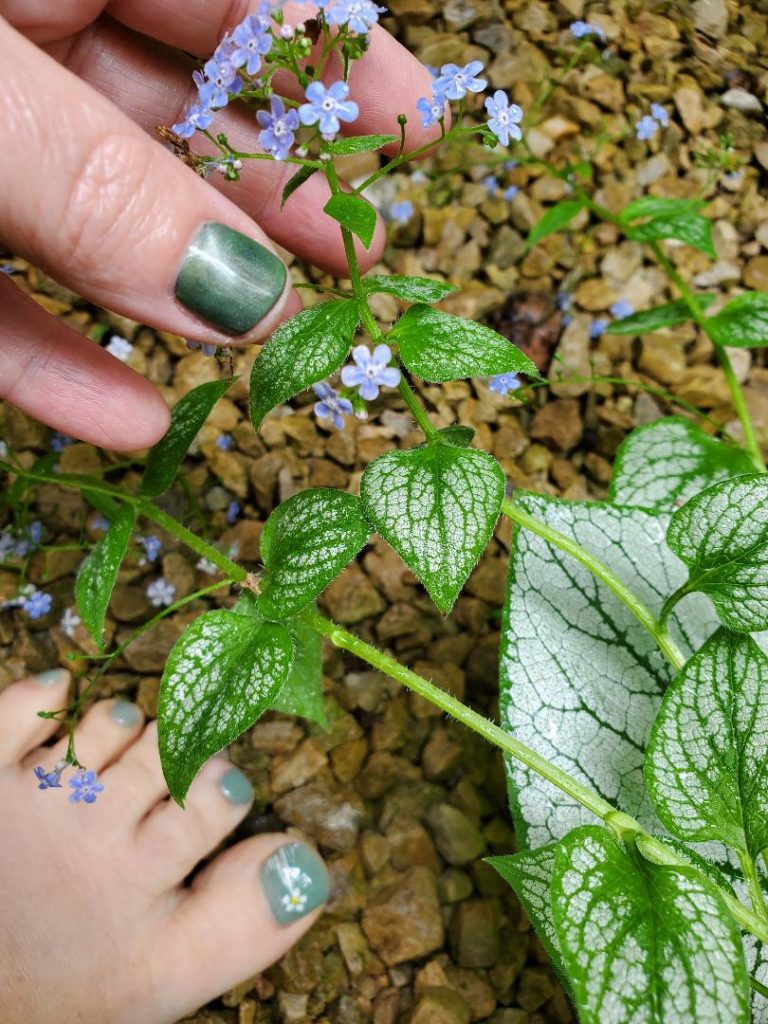
That got me thinking about the color green itself, and the thoughts and views surrounding it. I believe it has a very interesting story.
So, first lets look at the color itself first. What is green?
Adjective: of the color between blue and yellow in the spectrum; colored like grass or emeralds
Noun: green color or pigment
Verb: make or become green in color
I was very curious as to what the definition of green was and how it would be described. And all I got was “it’s between blue and yellow”. Well, that’s like saying the definition of a car is between a truck and bicycle. And it leaves a wide open space, because there is a lot of green!
So that raises the question, how much green are we really seeing?
For most people when they take a walk outside, they see green trees, green plants, green weeds, etc. I have to admit, back in the day, that is what I saw too. Just green.
And then Kermit the Frog’s little song, “It’s Not Easy Being Green” popped into my head.
He sings about green not being viewed as colorful, like red or orange, and it gets passed by everyone. And it blends in with so many other ordinary things.
But then at the end he says “I’m green, it’ll do fine. It’s beautiful. And I think it’s what I want to be”.
That made me stop and think, what have I passed by? What did I miss? Or was it intended for me to not observe it?
I don’t know about the past, but I do know that going forward I can see in between the blue and yellow and catch all the green.
What I mean by that, is now that I know many different plants, I can see between the “greens” and see all the tones and hues.

The psychological side of the color green takes on many forms. There are the good effects, the not so good, and a few in between.
How does green make you feel?
Well, that will depend on the situation, environment, or concept, right?
In researching the color, I found that green is mostly a positive color. It creates warmth, a sense a safeness, peacefullness and more.
And to think that nature is full of green! What does that tell us?
Plants are green for so many reasons, like the ones just mentioned.
Plants are comforting. Have you ever just gone out and sat on the grass or under a tree and felt at peace?
We feel safe in our homes, built from trees.
How many times did you look for that green four-leaf clover for good luck?
And, money does come from trees! Paper money that is. I know, dorky reason as to why plants are green.
But for real, why are plants green? Because they catch the red light. What?
True. Green is the complimentary color of red.
So, plants and their leaves look green because the “special pair” of chlorophyll molecules uses the red end of the visible light spectrum (light from the sun) to power reactions inside each cell.
The unused green light is reflected from the leaf and we see that light, which is green.
The chemical reactions of photosynthesis turn carbon dioxide from the air into sugars to feed the plant, and as a by-product the plant produces oxygen.
How cool is that!
That made me hungry…
So I have to share with you some “Green Bread”. Yes, green bread.
So when you first hear green bread, it’s like “Yuck!”
But not this kind!
My mother started making it years ago, and it has been a staple on the table for all family gatherings. My nieces and nephews just love it. It is very simple to make and freezes nicely if you want to save some for later.
Go HERE for the recipe of this wonderful, moist bread that is like a dessert!
I hope your family enjoys it as much as my family does.
And start looking at “GREEN” in a new way and seeing all the green that nature has to offer us!
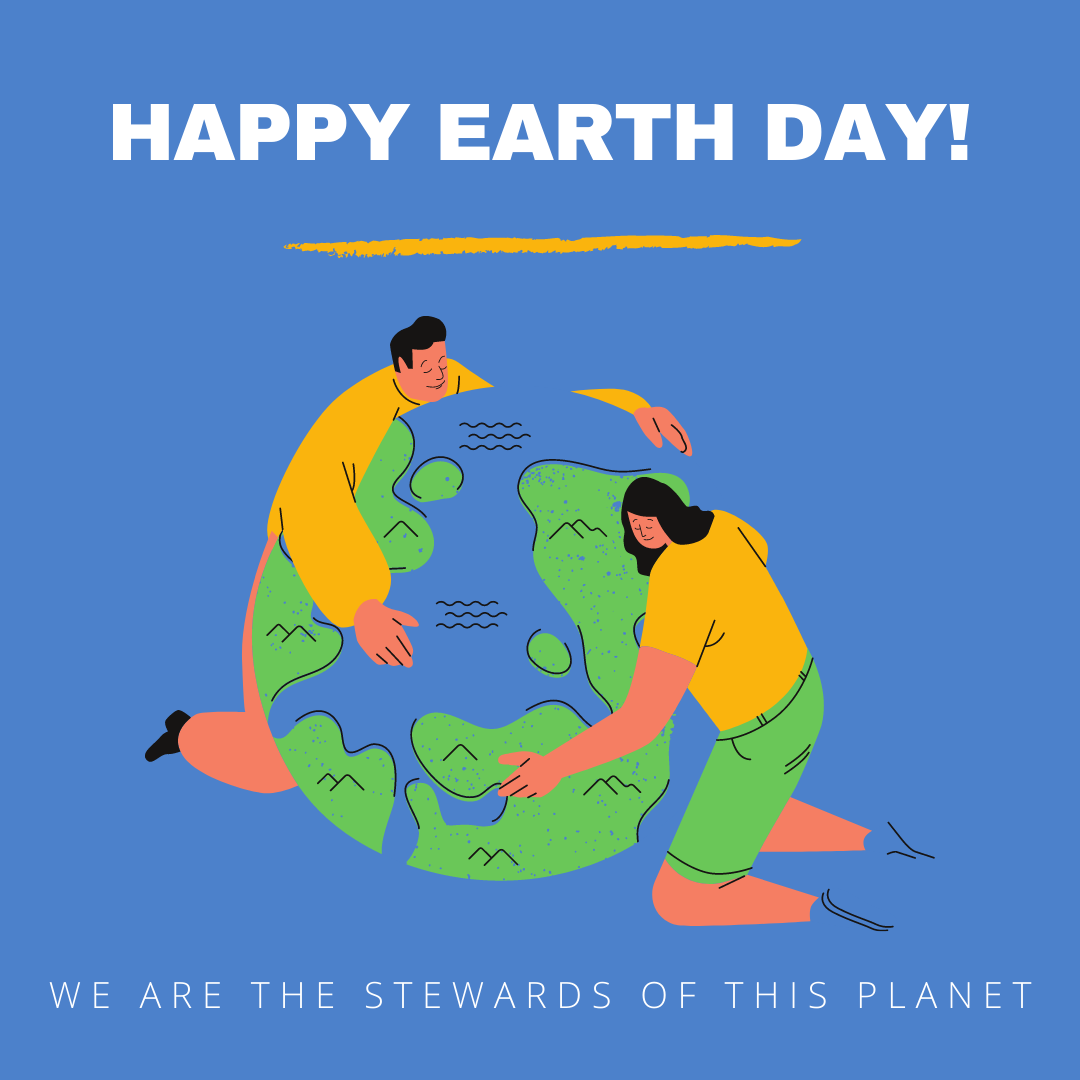
Did you know that Earth Day is the largest secular observance in the world? How cool is that!
This is the day where we can make an impact for the Earth. It is the day where we can begin taking care of the Earth like we want to be taken care of.
Earth Day began back in the 1970’s when there were policital and economical ups and downs. There were a number of people who became concerned with how we were treating our environment.
In 1970, Wisconsin Senator Gaylord Nelson introduced his idea for a ‘national teach-in on the environment’. This turned into the first Earth Day being celebrated across the United States on April 22, 1970. It pulled 20 million people together to promote a cleaner and safer living environment.
Over the decades, it grew to other countries and finally in 1990, it was global, with 141 countries and 200 million people celebrating Earth Day.
Earth Day is associated with “going green”. Going Green is defined as making more environmentally friendly decisions, such as to reduce, reuse and recycle.
And that’s great!
But are all Going Green decisions environmently friendly?
To find out, you have to dig deeper and look at the entire spectrum of the decision. Here are a couple “green” decisions to review.
Take a look at wind energy, which is one of the cheapest forms of clean energy. Wind turbines produce electricity from the turbines that spin generators.
Wind power is carbon-free and about 85% of turbine components, including steel, copper wire, electronics and gearing can be recycled or reused. But the fiberglass blades remain difficult to dispose of.
Tens of thousands of aging blades are coming down from steel towers around the world and most have nowhere to go but landfills. In the U.S. alone, about 8,000 will be removed in each of the next four years. These blades don’t disintagrate, and will be in the ground forever.
There are companies trying to find ways to recycle these turbine blades, but until then, what do we do with the blades? Is the final product worth filling landfills?
Another one in which to weigh the pros and cons is lithium, which is used in batteries, such as in electric cars. Take for example, the Tesla Model S battery, which has about 12 kilograms of lithium in it.
Lithium batteries are preferred over alkaline batteries for a number of reasons. First they last longer. They can withstand colder temperatures and they work better in portable devices, such as power tools.
But the mining and processing of lithium is far from being environmentally friendly. The extraction process uses a lot of water, and I mean a lot. When the water being used, “accidently” gets back into the environment, contamination takes place. In Nevada, researchers found impacts on fish as far as 150 miles downstream from a lithium processing operation.
Just because something is called “green”, doesn’t make it totally “green”. Research it and use your best judgement.
As stewards of the Earth, it is up to us to care for it so that it may take care of us in return.
There are many ways to take part as a care-taker for our planet.
For herbalists, Earth Day is recognizing that now is the time where plants are beginning to grow and start a new season.
Everyday we are stewards of the land as we share our knowledge and enthusiasm for the plant world. So in short, we celebrate Earth Day everyday!
But we, as herbalists and plant lovers, can do much more to help the planet. Here are some simple suggestions:
The Herbal Academy has a wonderful post called “How to be an environmentally sustainable Herbalist”. It has some great reminders on how we need to protect our plant world.
Want to try and see how much you know about deforestation and biodiversity?
Take the quiz HERE.
How did you do?
Did you learn anything new?
Is there something you can do today to start helping the environment?
If a pug can do it, we can do it!

“An anthology is like all the plums and orange peel picked out a cake.” Walter Raleigh
Eat orange peels?
Now most of us will drink orange juice or eat the inside slices of an orange. But the peel? Too bitter!
But before tossing that orange peel into the garbage, continue reading and be amazed!
The peel has so much to offer us in terms of medicinal properties and keeping us healthy. It has been used for thousands of years to treat different ailments.
Orange peel contains a large amount of Vitamin C and is a powerful antioxidant.
So lets learn a bit about how orange peel is good for us, make a cup of orange peel coffee, look at ways to get orange peel into your diet, and lastly, check out other ways to use up those orange peels.
In Need of Organic Orange Peels?
You can save the peels from organic oranges you purchased and dry them yourself. Easy peasy.
Or you can purchase them from Mountain Rose Herbs, who stand for organics, fair trade, sustainability and more.
Orange peel, along with other citrus fruits, have been used for thousands of years as medicine.
It contains flavanoids, Vitamins A, C, B5 and B6, calcium, riboflavin, thiamine, niacin, folate and dietary fiber.
Lets look at the 21 ways orange peel has been used over the years to help with overall health and how you can benefit.
1. Diarrhea
2. Indigestion
3. Constipation
4. Cleansing
In Traditional Chinese Medicine (TCM), the orange peel has been used for hundreds of years to help with gas, bloating and other digestive issues.
The orange peel contains pectin, which is a beneficial carbohydrate that the good bacteria in your gut feed off of.
5. Colds
6. Coughs
Because of its antibacterial, antifungal and antiviral properties, orange peel is a great for warding off cough and colds. It helps in getting excess phlegm out of the lungs.
7. Weight Loss
8. Obesity
9. Athletic Performance
A team of scientists in Taiwan researced the effects of four different orange peel varities, and found that they remarkably reduced the production and accumulation of triglycerides in fat cells.
10. Cholesterol
When taking in large amounts of orange and orange peel, the HDL increases, while the LDL decreases, which is great for those with high cholesterol.
11. High Blood Pressure
The potassium in orange peel plays a huge role in lowering the risk of high blood pressure.
12. Anxiety
13. Stress
14. Hypertension
15. Depression
Studies are now showing that by just inhaling the aroma of orange and orange peel, can have an uplifting effect on people.
16. Arthritis
17. Rheumatism
Orange peel contains powerful anti-inflammatory agents that help with swelling, redness and inflammation.
18. Asthma
19. Oral Health
20. Hangovers
21. Poor Circulation
So how can you get more orange peel into your diet? Let’s start with a cup of Orange Peel Coffee and then look at more ways to use those peels.
This coffee recipe is not only easy to make, but so good to drink!
Coffee has always been associated with caffeine and a morning pick-me-up. This cup of freshness is much more.
Smelling the citrus aroma while the orange peel is steeping in the hot coffee is just up-lifting.
Are you ready for some?
Here is the recipe for Orange Peel Coffee. I’ve taken it from HERE and adapted it to my tastings. That’s what makes this recipe so wonderful! You can adjust it to your likings.
Orange Peel Coffee
Ingredients:
Directions:
Enjoy my fun little video below on making Orange Peel Coffee!
Besides eating orange peel, there are a number of other uses for orange peel, so don’t throw it out! Unless it’s into the compost pile.
Here is a list of uses:
https://www.motherearthliving.com/cooking-methods/citrus-peel-medicine-coffee
https://www.webmd.com/vitamins/ai/ingredientmono-908/sweet-orange
https://www.motherearthliving.com/health-and-wellness/citrus-peel-medicine
https://www.linkedin.com/pulse/25-proven-health-benefits-orange-peel-tea-dr-paul-haider/
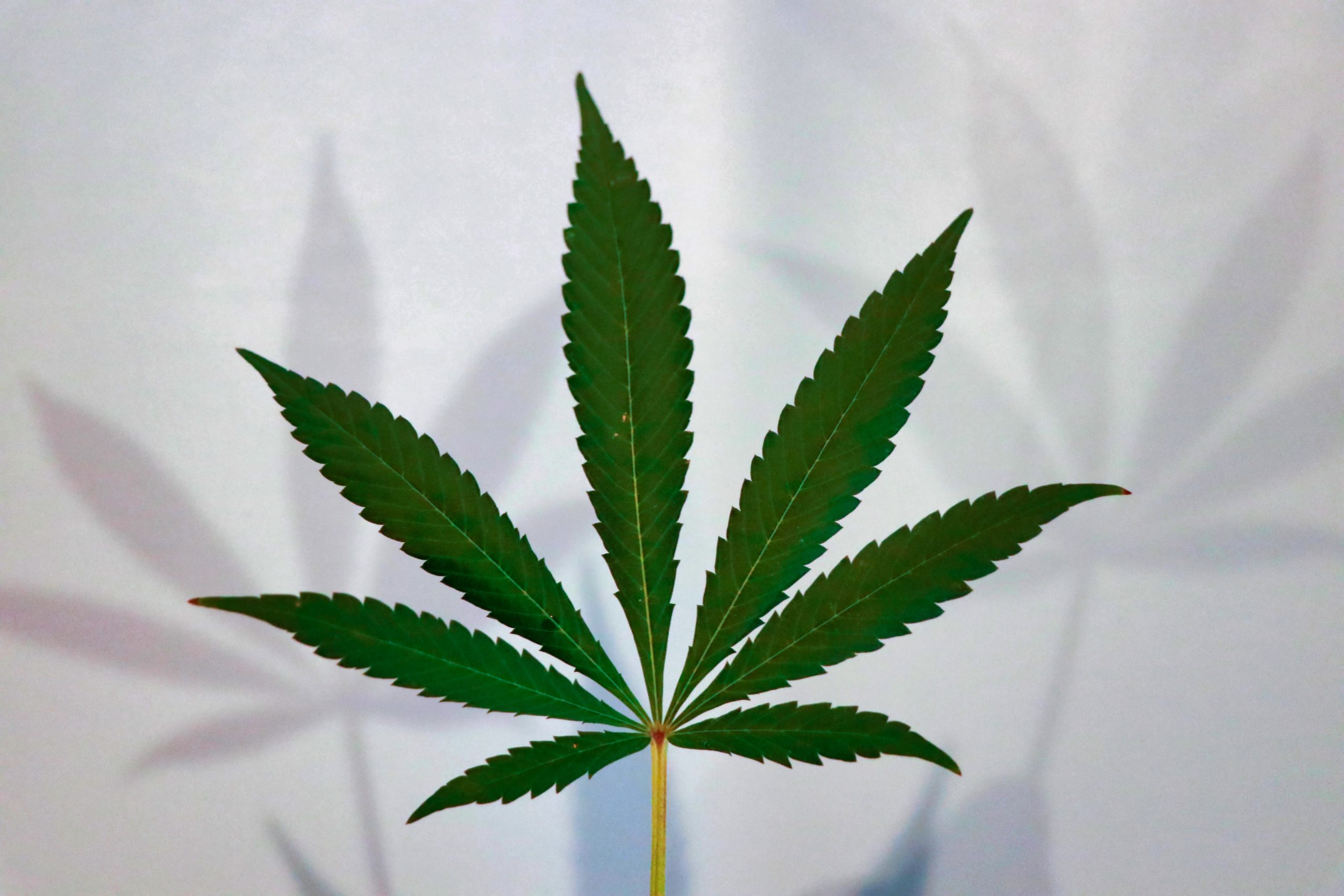
“What is a weed? A plant whose virtues have not yet been discovered.” Ralph Waldo Emerson
I thought there were probably only a few people out there that haven’t heard of CBD. Because friends and neighbors talk about it, it is advertised on the television, you can find it in natural retail stores and even at gas stations!
And it comes in all kinds of forms: liquid extracts, capsules, gummies, balms, ointments, lotions, bath bombs and even shampoo!
It’s like the new best thing!
But a recent Gallup poll showed that only 64% of US adults know about CBD.
Working in a retail store in the supplement and body care department, I deal first hand with customers looking for CBD. It is very interesting to listen to them as to what they have heard or read about it. There is a lot of misconceptions about CBD and some people don’t understand it. Some think it is marijuana. Yikes!
CBD doesn’t get you high, it gets you healthy.
So sit back and let me share with you some of the CBD basics I tell my customers at the brick and mortar store and if it may be beneficial for you. Because CBD is not for everyone.
CBD is the acronym for cannabidiol.
Canna what?
That is why we just go with CBD. Much easier, right?
CBD comes from the cannabis plant and is only one of over 100 phytocannabinoids (phyto meaning plant) that have been identified up to now.
THC, another phytocannabinoid in cannabis, is the one that creates intoxicating effects. CBD does not. So you can NOT get high from taking CBD.
In relation to all of this, you may have heard the term hemp. So you may be asking yourself, how do all of these differentiate?
Let’s take a look.
First we have the genus Cannabis.
Cannabis is then broken into two species, hemp (CBD) and marijuana.
The infographic below shows the entire tree lineage for cannabis.
Fun Fact: Hops is in the Cannabaceae Family!
In talking to customers, I compare apples to show the difference. We have apples, many varieties of apples, but they are all still apples. Same with cannabis.
The term hemp is used to differentiate the two species of cannabis because it has 0.3% or less of THC.
I will have a customer here and there ask for hemp oil, when they are really looking for CBD oil. Hemp oil is derived from the seed of the cannabis plant and contains no CBD or THC.
CBD works on the endocannabinoid system, which was only discovered 25 years ago, so it is still fairly new in the field of science. It works on the receptors throughout the body to help keep the endocannabinoid system in balance.
The endocannabinoid system receptors are responsible for managing a variety of different things, including appetite, mood, energy, and much more.
Our body naturally synthesizes what are called endogenous cannabinoids, which are chemical messengers that interact with these receptors. CBD, a phytocannabinoid, interacts the same way.
So all in all, receptors in our nervous system and immune system react to cannabis compounds and produce specific effects that may benefit many bodily processes.
Fun Fact: Cannabis is one of the oldest medicinal plants used by humans!
According to the Gallup Poll mentioned earlier, 14% of Americans use CBD products. What they take it for is as follows:
This coincides with what I see at my workplace. Most people are looking for help with pain.
Hemp is hope, not dope
Remember, CBD does not cure any disease, it is just a way to help the body feel better.
When looking for CBD, you’ll see that it is available in almost any form you can think of.
CBD comes in a number of edible forms, such as liquid extract, oils, capsules, gummies, etc. Some people don’t want to take another pill, so they opt for the extract or gummy. Others are worried about the taste and will go for the pill to avoid tasting the hemp. And yes, some of the extracts and gummies come in flavors, such as peppermint or cherry, but all the ones I’ve tasted do give me an aftertaste of hemp. I don’t mind the taste, but a number of people do mind it.
Me taking a CBD gummy!
The liquid oils are usually the most potent and unprocessed form. Also, it is the easiest way to control your dosage.
CBD also comes in a number of topical forms. You can find balms, ointments, lotions and even bath salts! These are nice for those who don’t want to ingest anything. And it can be applies right where you want it, like on arthritic hands.
Everyone reacts differently to CBD. And you need to find a dosage that works for you. CBD is not a one-size-fits-all.
Will it work?
I tell my customers that CBD doesn’t know what you are taking it for. You may want it for pain, but it helps you sleep much better. CBD just goes in and does its thing. I ask customers to pay attention to any and all suttle changes that may occur when taking CBD.
Also, some people will notice changes quickly, while others may take hours, days or even weeks to feel a difference.
And more is not always better. Some people think they need to take a high dosage right off the bat. NO! All experts I’ve spoken too say to start with a low dosage and work your way up till you find that it works for you. There are a number of reasons for this.
First, if you take too much CBD, it may do nothing at all. I had a customer tell me she was taking a smaller dosage for some time that worked for her. She then wanted to try a higher dosage. She did and nothing happened. She went back to her lower dosage and it started working again.
Second, if you take to much, you could have some side effects such as upset stomach, nausea, headaches or dizziness. That is your body saying you took way too much CBD for your system.
So far, it does not look like one can build up a “tolarence” for CBD.
According to Junella Chin, DO, an osteopathic physician and a medical cannabis expert for cannabisMD, about 5% of people say they feel altered after taking CBD. She says these are usually the same people who have side effects when taking Advil or Tylenol.
But with all that, most of the customers I talk to say CBD has helped them in some way, whether for pain, sleep, anxiety, etc. I even had one elderly lady say she didn’t know if it was just in her head, or if it really took away the pain, but she was going to keep taking it either way because she felt better.
Make sure when shopping for CBD to that it is third-party tested for quality assurance. Because CBD is not regulated by the FDA, it may not be exactly what the label says. The 2017 Journal of the American Medical Association study, for example, which tested 84 CBD products, found that 26% contained lower doses than what was stated on the label.
Keep in mind, if you take CBD, it could show up on a drug test.
There are a lot of CBD brands out there, so where do you start?
First, make sure the brand you are looking at is third-party tested. That way you know you are getting what is listed on the label.
Second, research the brand or brands. Have they been working with CBD for years or did they just get on the band wagon? What is their mission statement? What do they stand for?
Third, don’t just look at the price. There are some brands out there that are more expensive, but you are paying for their marketing and packaging. Research the company.
Lastly, compare apples to apples. Some of the brands will list serving size according to CBD content, while others use hemp. And with liquids, the amount listed on the front of the bottle is usually for the entire bottle, not a single serving. So make sure you are comparing like to like.
My go-to brand is CV Sciences (also know as PlusCBD) for many reasons.
I take it to help me get a good nights rest. It helps to calm me down after a busy day. I don’t take it everyday, just when I feel I need it.
You can find out more about CV Sciences and ordering CBD HERE.
As with any supplement, before taking research it. Know what it does, how it affects people, etc. You know yourself more then anyone, so you decide what you need to live a more happy and painfree life.
https://www.health.com/condition/pain/what-is-cbd
https://www.healthline.com/health/hemp-vs-marijuana#legality
https://draxe.com/nutrition/what-is-cbd-cannabidiol/
https://news.gallup.com/poll/263147/americans-say-cbd-products.aspx
https://www.sciencedirect.com/science/article/pii/B9780128007563000016
https://www.beautyarmy.com/lifestyle/to-understand-the-misunderstood-15-great-quotes-about-cbd-oil/
**Some links in this article may be affiliate links.